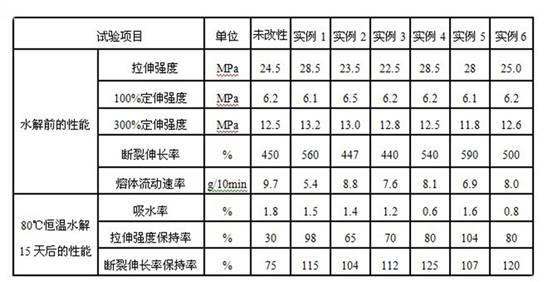Hydrolysis-resistant thermoplastic polyurethane elastomer and manufacture method thereof
A technology of thermoplastic elastomer and polyurethane, which is applied in the field of hydrolysis-resistant thermoplastic elastomer materials and its manufacture, can solve the problems of decreased mechanical properties and poor hydrolytic stability, and achieve excellent mechanical properties, improved hydrolytic stability, and good processing fluidity Effect
- Summary
- Abstract
- Description
- Claims
- Application Information
AI Technical Summary
Problems solved by technology
Method used
Image
Examples
Embodiment 1
[0022] Weigh raw materials, thermoplastic polyurethane resin: 100 parts of polyester TPU resin; anti-hydrolysis compound: 4 parts of polycarbodiimide; antioxidant: tetrakis[methyl-β-(3,5-di-tert-butyl-4- Hydroxyphenyl) propionate] 0.15 parts of pentaerythritol esters; lubricant: 0.2 parts of zinc stearate.
[0023] Mixing: polyester TPU resin with polycarbodiimide, tetrakis[methyl-β-(3,5-di-tert-butyl-4-hydroxyphenyl) propionate] pentaerythritol ester, zinc stearate, etc. Blend well in a blender.
[0024] Granulation: Extrude with a twin-screw extruder, granulate, and finally dry and pack.
[0025] In the granulation step, the temperature of each section of the twin-screw extruder starting from the feeding port is 165~168°C, 170~175°C, 175~180°C, 175~180°C, 175~180°C, 175~180°C, The head temperature is 172~175°C.
[0026] The modified material exhibits excellent mechanical properties, hydrolytic stability (see Table 1), and good molding processability.
Embodiment 2
[0028] Weigh raw materials, thermoplastic polyurethane resin: 100 parts of polyester TPU resin; anti-hydrolysis compound: 3 parts of 1, 2-epoxy-3-phenoxypropane; antioxidant: tetrakis[methyl-β-(3,5 - 0.2 parts of di-tert-butyl-4-hydroxyphenyl propionate] pentaerythritol ester; lubricant: 0.3 parts of calcium stearate.
[0029] Mixing: polyester TPU resin with 1, 2-epoxy-3-phenoxypropane, tetrakis[methyl-β-(3,5-di-tert-butyl-4-hydroxyphenylpropionate) pentaerythritol Ester and calcium stearate are mixed evenly in a blender.
[0030] Granulation: Extrude with a twin-screw extruder, granulate, and finally dry and pack.
[0031] In the granulation step, the temperature of each section of the twin-screw extruder starting from the feeding port is 165~168°C, 170~175°C, 175~180°C, 175~180°C, 175~180°C, 175~180°C, The head temperature is 172~175°C.
[0032] The modified material exhibits excellent mechanical properties, hydrolytic stability (see Table 1), and good molding processabi...
Embodiment 3
[0034] Weigh raw materials, thermoplastic polyurethane resin: 100 parts of polyester TPU resin; anti-hydrolysis compound: 4 parts of bisphenol A diglycidyl ether with an epoxy value of 0.48~0.52; antioxidant: 4, 4'-di-tert-octyl 0.3 part of diphenylamine; lubricant: 0.25 part of zinc stearate.
[0035] Mixing: Mix polyester TPU resin with bisphenol A diglycidyl ether, 4, 4'-di-tert-octyldiphenylamine and zinc stearate in a blender evenly.
[0036] Granulation: Extrude with a twin-screw extruder, granulate, and finally dry and pack.
[0037] In the granulation step, the temperature of each section of the twin-screw extruder starting from the feeding port is 165~168°C, 170~175°C, 175~180°C, 175~180°C, 175~180°C, 175~180°C, The head temperature is 172~175°C.
[0038] The modified material exhibits excellent mechanical properties, hydrolytic stability (see Table 1), and good molding processability.
PUM
| Property | Measurement | Unit |
|---|---|---|
| epoxy value | aaaaa | aaaaa |
Abstract
Description
Claims
Application Information
 Login to View More
Login to View More - R&D
- Intellectual Property
- Life Sciences
- Materials
- Tech Scout
- Unparalleled Data Quality
- Higher Quality Content
- 60% Fewer Hallucinations
Browse by: Latest US Patents, China's latest patents, Technical Efficacy Thesaurus, Application Domain, Technology Topic, Popular Technical Reports.
© 2025 PatSnap. All rights reserved.Legal|Privacy policy|Modern Slavery Act Transparency Statement|Sitemap|About US| Contact US: help@patsnap.com

